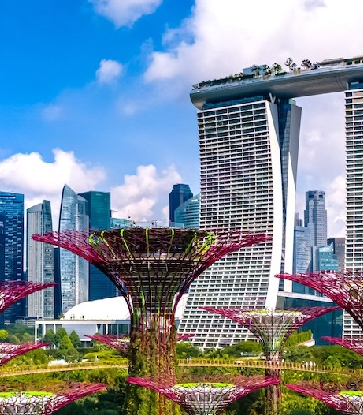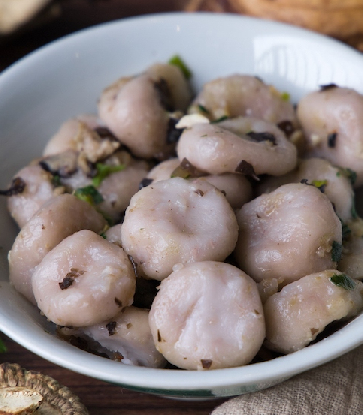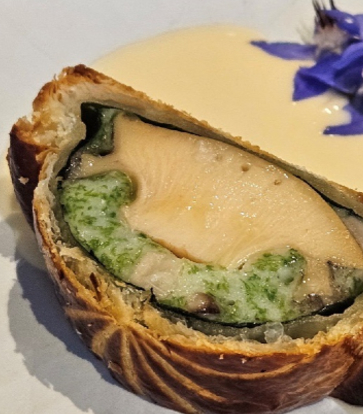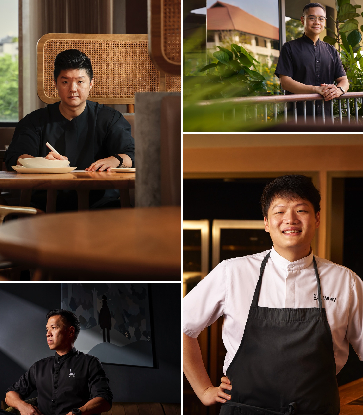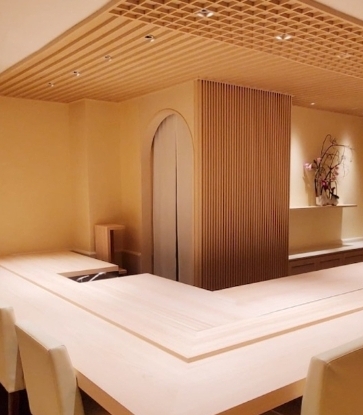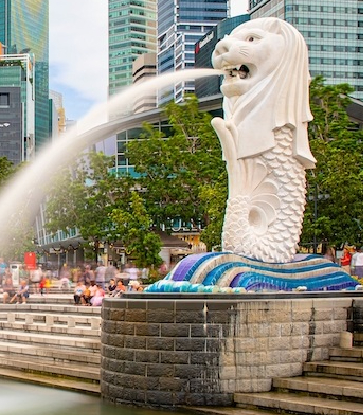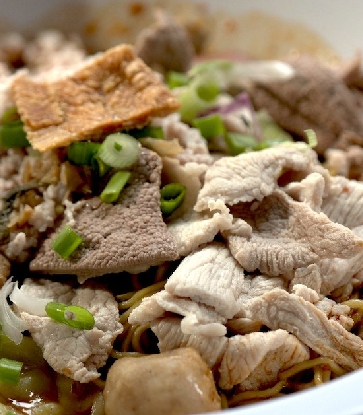Kueh is a collective term used in Malaysia and Singapore for the colourful, irresistibly enticing, bite-sized sweetmeats that one sees everywhere: at the local morning market, a cake shop, as part of an afternoon tea spread, or even on a prayer altar to the gods. Multi-varietal, overflowing with richness and sweetness, and always vibrantly coloured, Kuehs mirror the joie de vivre of both countries' local culinary culture.
However, compared to other desserts in the region, the Kueh betrays its Southeast Asian persona with the presence of the “Holy Trinity” of ingredients in many of its incarnations: rice flour, coconut milk, and pandan. And it has to be sweet.
A number of Kuehs in Malaysia and Singapore were adapted from the Thais who, in turn, learnt many of their present-day desserts from a Portuguese-Eurasian lady, Maria Guyomar de Pinha, who lived in 17th-century Ayutthaya and headed the kitchens of the Siamese royal court at one time.
In Malaysia and Singapore, the colourful Nyonya kuehs made by the Straits-born Chinese (Baba-Nyonya) community are especially favoured for their richness and finesse, and the best renditions are said to be found in the former Straits Settlements of Penang, Singapore, and Malacca.
Here are some of the popular types of Kueh that can be found in Malaysia and Singapore:

Kueh Lapis
Kueh Lapis is the classic steamed rice pudding — a blend of rice and sago flour, sweetened with sugar syrup, enriched with coconut milk, and perfumed by the fragrance from pandan leaves.
The Kueh Lapis is painstakingly steamed layer-by-layer — it has eight layers that are alternatively coloured white-and-pink, topped by a bright orange-red top layer, hence its Hokkien name “kow teng kueh” meaning nine-layer cake. The Thais have a similar kueh called “khanom chan” which also consists of nine layers. The Thais traced its origins to the Sukhothai period (1238–1347 CE), when trading activities with the Chinese resulted in culinary exchanges as well.
The auspiciousness of the number nine to the Chinese, which represents attainment and completion, can be traced back to the ancient Book of Songs, a collection of poetry dating back to the 11th-century BC. For the Thais, the number also reflects the Buddhist philosophy of The Nine Consciousness of one’s life.

Kueh Bengka
Kueh Bengka is a steamed-then-baked tapioca pudding. The addition of eggs and coconut milk accentuate the moist pudding’s rich flavour, whilst the baking gives it a delicious golden-brown crust.
Of Banjarese origin (from southeast Kalimantan, Indonesia), the very popular Kueh Bengka was adopted very early on by the Malays and Straits-born Chinese into their repertoire of sweetmeats.

Pulut Tai Tai/Pulut Tekan
Pulut Tai Tai is basically a compressed glutinous rice cake — its name is purportedly a mispronunciation by Penang Nyonyas of the Malaccan Kristang word, “tartal”, meaning to press. Traditionally, Pulut Tai Tai has a mottled blue-white appearance, made using the natural colours of butterfly pea flower.
Singaporeans and Malaccans prefer to use the term pulut tekan (Malay for “pressed glutinous rice”). Accompanying the Pulut Tai Tai is the indispensable kaya, a thick, sweet custard made from eggs, sugar and coconut milk — slowly cooked until thick and gold-hued from the caramelisation of the sugar content. Kaya is believed to have been adopted from the Thai sangkaya, which was also one of Pinha's many creations.
Traditionally, the Straits-born Chinese eschewed blue or black kuehs, as they are regarded as mourning colours, only to be used for sombre occasions. However, Pulut Tai Tai is rendered “acceptable” with the addition of “gold on top” that takes the form of the “gold”-hued kaya egg-custard.
The same goes with the blue-tinted Pulut Inti, with its “gold” Inti (grated coconut-palm sugar) and mottled blue-white Apom Berkuah (a blue pea flower rice pancake) with its “gold” Pengat (banana-coconut milk-palm sugar sauce).

Pulut Inti
Pulut Inti is another popular glutinous rice dessert, but not compressed like Pulut Tai Tai. For the Nyonyas, it’s tinged blue using bunga telang (blue pea flower), and then topped with a grated-coconut-palm-sugar inti. The Malay Pulut Inti is similar in taste and texture to its Nyonya counterpart, except that the Malays leave the glutinous rice an un-tinted white.

Rempah Udang/Pulut Panggang
Rempah Udang, as it’s known in Penang, is called Pulut Panggang (meaning “grilled glutinous rice”) in Singapore. Of Indonesian origin, it consists of steamed glutinous rice with a spiced prawn-and-grated-coconut filling. The mixture is tightly wrapped in banana leaves into tubular rolls before bring grilled over an open fire, the Rempah Udang has a deliciously smoky aroma.
Called “lemper” in Indonesia, it obtained its Penang moniker by accident. Linguistically-challenged, early 20th-century Penang-Chinese had commonly mispronounced the Malay word “rempah” (meaning spice paste) as “lempah”. When lemper was introduced to Penang, the locals had misheard “lemper udang” as “lempah udang”. Over time, the term was wrongly “corrected” to become “rempah udang”.
Mispronunciation or not, it makes for a delicious snack at any time of the day.
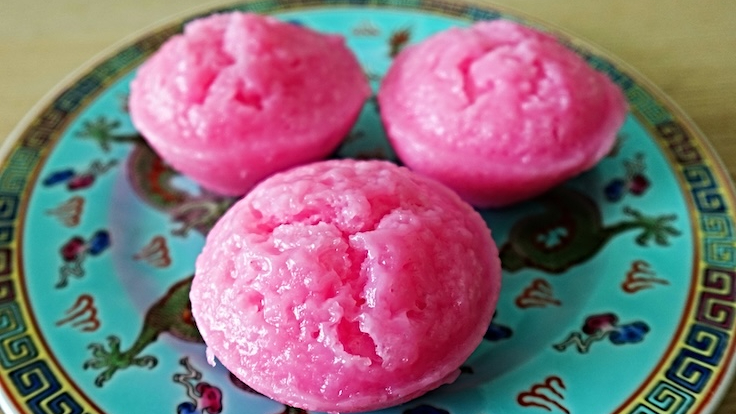
Huat Kueh
Huat Kueh is a traditional Southern Chinese steamed glutinous rice flour cake used for prayer offerings and also as gifts to family and friends. “Huat” means “to grow” in the Hokkien dialect, but it also sounds like “to prosper”, hence the auspiciousness attached to Huat Kueh. Its signature pink colour represents joyousness. Its Mandarin pronunciation is fa gao (发糕).
Originally made by farmers north of Fujian using leftover rice grains for their own consumption, Huat Kueh later became prayer offerings to the gods, in gratitude for bountiful harvests.
By the time of the Ming Dynasty (1368-1644 AD), Huat Kueh was regarded as auspicious gift-cakes, to be distributed to relatives and friends during the New Year or celebratory occasions.

Ang Ku Kueh
Ang Ku Kueh (literally, “red tortoise rice-cake”) is an auspicious kueh used for prayer offerings to the gods during important religious events like the Chinese Lunar New Year; it is also distributed during a one-month-old-baby’s celebration. Of Fujianese origin, the Ang Ku Kueh is brought to Southeast Asia by Hokkien emigrants.
Ang Ku Kueh has a soft, bright red-coloured, glutinous rice-flour skin, filled with mashed, sweetened mung beans. Shaped like a tortoise, it’s believed to bestow long life and prosperity upon the eater.

Kueh Dadar/Kueh Ketayap
Kueh Dadar is a very popular rolled crêpe with a palm-sugar-grated-coconut filling. Of Javanese origin, it is known as Gulung Dadar in Indonesia. The crêpe’s similarity to the Dutch pannenkoeken — thin, yet moist, and dense — perhaps betrays its origins. The Dutch first settled in West Java in 1603, and ruled over much of what is to become modern-day Indonesia for more than three centuries. Its influence on Indonesia’s culinary culture is extensive.
Gulung Dadar translates as “rolled omelette”. The Nyonya term for it, Kueh Dadar, is adopted from its Javanese name, referring to its moist, eggy, pandan-scented green crêpe.
It’s commonly known as Kueh Ketayap in Malay, as the round, unfolded crêpe is reminiscent of a “ketayap” or Malay skull-cap.
Where to Enjoy Kueh in Kuala Lumpur & Penang:
Auntie Gaik Lean’s Old School Eatery (One MICHELIN Star, MICHELIN Guide Kuala Lumpur & Penang 2024)
Bibik’s Kitchen (Bib Gourmand, MICHELIN Guide Kuala Lumpur & Penang 2024)
Moh Teng Pheow Nyonya Koay (Bib Gourmand, MICHELIN Guide Kuala Lumpur & Penang 2024)
Kebaya Dining Room (Selected Restaurant, MICHELIN Guide Kuala Lumpur & Penang 2024)
Where to Enjoy Kueh in Singapore:
Candlenut (One MICHELIN Star, MICHELIN Guide Singapore 2023)
Hjh Maimunah (Jalan Pisang) (Bib Gourmand, MICHELIN Guide Singapore 2023)
Indocafé – The White House (Bib Gourmand, MICHELIN Guide Singapore 2023)
The Coconut Club (Bib Gourmand, MICHELIN Guide Singapore 2023)
True Blue Cuisine (Bib Gourmand, MICHELIN Guide Singapore 2023)
Rempapa (Selected Restaurant, MICHELIN Guide Singapore 2023)
Straits Chinese (Selected Restaurant, MICHELIN Guide Singapore 2023)
Header image is from Shutterstock. All other images are by Peter Yeoh.






